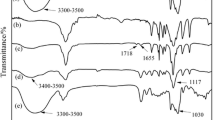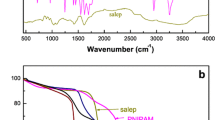Abstract
Dual-responsive nanogels were prepared by polymerization of itaconic acid (IA) and copolymerization with methacrylic acid (MA) in aqueous solution of hydroxypropyl cellulose (HPC) and cross-linking with N, N′-methylenebisacrylamide (MBAm) through an easy and green process. FTIR spectroscopy, TEM, AFM, DLS and zeta potential studies confirmed the semi-interpenetrating (semi-IPN) polymer network structure of nanogels. The LCST of HPC was increased to a higher temperature than HPC’s intrinsic LCST, while the presence of the MA comonomer improved the hydrophobicity of the copolymer and reduced LCST to about body temperature and suppressed the excessive nanogel aggregation. It was found that the concentration of reactants impacted the process of nanogel formation. Additionally, an increasing of cross-linker concentration led to a reduced size of HPC nanogels. Besides, the diameter of nanogels was changed with the temperature and pH. TEM and AFM photographs of copolymer nanogels illustrated that the nanoparticles with small diameters (<100 nm) were prepared. With loading the doxorubicin into the copolymer nanogels, the particle size became larger (about 150 nm) and due to the electrostatic interaction of the cationic drug with anionic particles, the zeta potential was increased. Drug release processes were followed at pH = 5.0 and 7.4 and with 37- and 41-°C temperatures, respectively. The maximum in-vitro release studies of drug-loaded nanogels, which is 91% for the pH 5.0 buffer solution at 41 °C, demonstrated the temperature- and pH-sensitivity of prepared copolymer nanogels.





Similar content being viewed by others
References
Cheng Z, Al Zaki A, Hui JZ, Muzykantov VR, Tsourkas A (2012) Multifunctional nanoparticles: cost versus benefit of adding targeting and imaging capabilities. Science 338(6109):903–910
Petros RA, DeSimone JM (2010) Strategies in the design of nanoparticles for therapeutic applications. Nat Rev Drug Discov 9(8):615–627
Kabanov AV, Vinogradov SV (2009) Nanogels as pharmaceutical carriers: finite networks of infinite capabilities. Angew Chem Int Ed 48(30):5418–5429
Zha L, Banik B, Alexis F (2011) Stimulus responsive nanogels for drug delivery. Soft Matter 7(13):5908–5916
Oh JK, Drumright R, Siegwart DJ, Matyjaszewski K (2008) The development of microgels/nanogels for drug delivery applications. Prog Polym Sci 33(4):448–477
Chiang WH, Huang WC, Chang YJ, Shen MY, Chen HH, Chern CS, Chiu HC (2014) Doxorubicin-loaded Nanogel assemblies with pH/Thermo-triggered payload release for intracellular drug delivery. Macromol Chem Phys 215(13):1332–1341
Li M, Tang Z, Sun H, Ding J, Song W, Chen X (2013) pH and reduction dual-responsive nanogel cross-linked by quaternization reaction for enhanced cellular internalization and intracellular drug delivery. Polym Chem 4(4):1199–1207
Lu X, Hu Z, Schwartz J (2002) Phase transition behavior of hydroxypropylcellulose under interpolymer complexation with poly (acrylic acid). Macromolecules 35(24):9164–9168
Pather SI, Robinson JR, Eichman JD, Khankari RK, Hontz J, Gupte SV (2002) Effervescent drug delivery system for oral administration. Google Patents
Xihua Lu B (2002) Polymer hydrogel nanoparticles and their networks. University of North Texas
Bai Y, Zhang Z, Zhang A, Chen L, He C, Zhuang X, Chen X (2012) Novel thermo-and pH-responsive hydroxypropyl cellulose-and poly (l-glutamic acid)-based microgels for oral insulin controlled release. Carbohydr Polym 89(4):1207–1214
Tan J, Kang H, Liu R, Wang D, Jin X, Li Q, Huang Y (2011) Dual-stimuli sensitive nanogels fabricated by self-association of thiolated hydroxypropyl cellulose. Polym Chem 2(3):672–678
Zhang Z, Chen L, Zhao C, Bai Y, Deng M, Shan H, Zhuang X, Chen X, Jing X (2011) Thermo-and pH-responsive HPC-g-AA/AA hydrogels for controlled drug delivery applications. Polymer 52(3):676–682
Chen Y, Ding D, Mao Z, He Y, Hu Y, Wu W, Jiang X (2008) Synthesis of hydroxypropylcellulose-poly (acrylic acid) particles with semi-interpenetrating polymer network structure. Biomacromolecules 9(10):2609–2614
Liao Q, Shao Q, Wang H, Qiu G, Lu X (2012) Hydroxypropylcellulose templated synthesis of surfactant-free poly (acrylic acid) nanogels in aqueous media. Carbohydr Polym 87(4):2648–2654
An D, Zhao D, Li X, Lu X, Qiu G, Shea KJ (2015) Synthesis of surfactant-free hydroxypropylcellulose nanogel and its dual-responsive properties. Carbohydr Polym 134:385–389
Liao R, Lei Y, Wan J, Tang Z, Guo B, Zhang L (2012) Dispersing graphene in hydroxypropyl cellulose by utilizing its LCST behavior. Macromol Chem Phys 213(13):1370–1377
Guo B-L, Gao Q-Y (2007) Preparation and properties of a pH/temperature-responsive carboxymethyl chitosan/poly (N-isopropylacrylamide) semi-IPN hydrogel for oral delivery of drugs. Carbohydr Res 342(16):2416–2422
Prabaharan M, Mano JF (2006) Stimuli-responsive hydrogels based on polysaccharides incorporated with thermo-responsive polymers as novel biomaterials. Macromol Biosci 6(12):991–1008
Zhang GQ, Zha LS, Zhou MH, Ma JH, Liang BR (2005) Preparation and characterization of pH-and temperature-responsive semi–interpenetrating polymer network hydrogels based on linear sodium alginate and crosslinked poly (N-isopropylacrylamide). J Appl Polym Sci 97(5):1931–1940
Zhao Y, Kang J, Tan T (2006) Salt-, pH-and temperature-responsive semi-interpenetrating polymer network hydrogel based on poly (aspartic acid) and poly (acrylic acid). Polymer 47(22):7702–7710
Kalagasidis Krušić M, Veličković SJ, Griffiths PC, Filipović J (2010) Poly [(N-isopropylacrylamide)-co-(itaconic acid)] hydrogels with poly (ethylene glycol). Polym Int 59(2):256–262
Bagheri M, Pourmirzaei L (2013) Synthesis and characterization of cholesteryl-modified graft copolymer from hydroxypropyl cellulose and its application as nanocarrier. Macromol Res 21(7):801–808
Bagheri M, Shateri S, Niknejad H, Entezami AA (2014) Thermosensitive biotinylated hydroxypropyl cellulose-based polymer micelles as a nano-carrier for cancer-targeted drug delivery. J Polym Res 21(10):1–15
Bagheri M, Pourmoazzen Z, Entezami AA (2013) pH-responsive nanosized-micelles based on poly (monomethylitaconate)-co-poly (dimethylaminoethyl methacrylate) and cholesterol side chains effect on pH change-induced release of piroxicam. J Polym Res 20(9):1–11
Pourmoazzen Z, Bagheri M, Entezami AA, Koshki KN (2013) pH-responsive micelles composed of poly (ethylene glycol) and cholesterol-modified poly (monomethyl itaconate) as a nanocarrier for controlled and targeted release of piroxicam. J Polym Res 20(12):1–12
Bagheri M, Shateri S (2012) Thermosensitive nanosized micelles from cholesteryl-modified hydroxypropyl cellulose as a novel carrier of hydrophobic drugs. Iran Polym J 21(6):365–373
Pourmoazzen Z, Bagheri M, Entezami AA (2014) Cholesteryl-modified poly (monomethyl itaconate) s micelles as nano-carriers for pH-responsive drug delivery. Polym J 46(11):806–812
Razzaq R, Ranjha NM, Rashid Z (2016) Preparation and evaluation of novel pH-sensitive poly (butyl acrylate-co-itaconic acid) hydrogel microspheres for controlled drug delivery. Adv Polym Technol
Jain N (2004) Progress in controlled and novel drug delivery systems. CBSS. Gopalakrishnan et al. Journal of Pharmaceutical Science and Technology Publishers and Distributors, New Delhi, Bangalore 3(2):84–85
Shidhaye S, Lotlikar V, Malke S, Kadam V (2008) Nanogel engineered polymeric micelles for drug delivery. Curr Drug Ther 3(3):209–217
Zhan Y, Gonçalves M, Yi P, Capelo D, Zhang Y, Rodrigues J, Liu C, Tomás H, Li Y, He P (2015) Thermo/redox/pH-triple sensitive poly (N-isopropylacrylamide-co-acrylic acid) nanogels for anticancer drug delivery. J Mater Chem B 3(20):4221–4230
Xiong W, Wang W, Wang Y, Zhao Y, Chen H, Xu H, Yang X (2011) Dual temperature/pH-sensitive drug delivery of poly(N-isopropylacrylamide-co-acrylic acid) nanogels conjugated with doxorubicin for potential application in tumor hyperthermia therapy. Colloids Surf B: Biointerfaces 84:447–453
Acknowledgements
We thank the Vice Chancellor of Research of Azarbaijan Shahid Madani University for financially supporting this research.
Author information
Authors and Affiliations
Corresponding author
Rights and permissions
About this article
Cite this article
Hassanpour, S., Bagheri, M. Dual-responsive semi-IPN copolymer nanogels based on poly (itaconic acid) and hydroxypropyl cellulose as a carrier for controlled drug release. J Polym Res 24, 91 (2017). https://doi.org/10.1007/s10965-017-1246-z
Received:
Accepted:
Published:
DOI: https://doi.org/10.1007/s10965-017-1246-z




